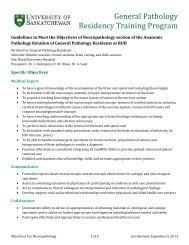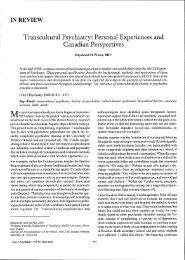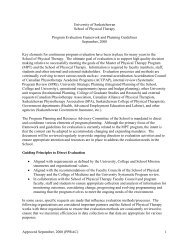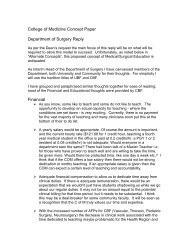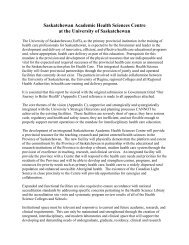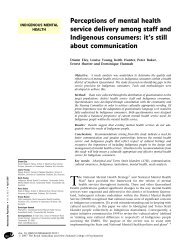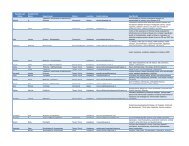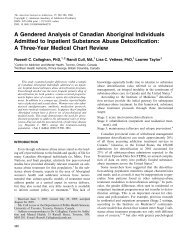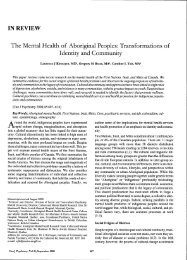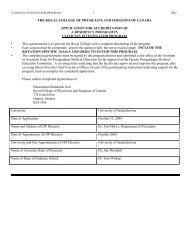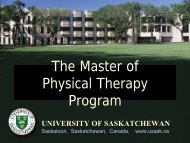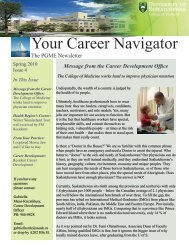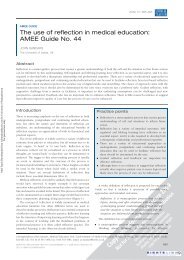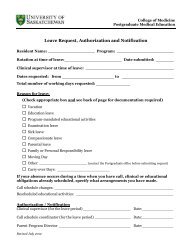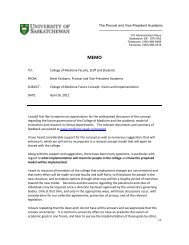connective issue - College of Medicine - University of Saskatchewan
connective issue - College of Medicine - University of Saskatchewan
connective issue - College of Medicine - University of Saskatchewan
You also want an ePaper? Increase the reach of your titles
YUMPU automatically turns print PDFs into web optimized ePapers that Google loves.
<strong>College</strong> <strong>of</strong> <strong>Medicine</strong> Alumni Spring 2007<br />
<strong>connective</strong> <strong>issue</strong><br />
Helping Celebrate the 50th Anniversary<br />
IN THIS ISSUE<br />
Greetings from the Dean ..............................2<br />
Greetings from the President ......................2<br />
Editor’s Comments ..........................................3<br />
<strong>Saskatchewan</strong>’s Red Dean ..........................4<br />
Making a SWITCH ..........................................4<br />
The Class <strong>of</strong> ‘57 ...............................................6<br />
2005<br />
Fall<br />
A Pre Med Moment ........................................8<br />
Lives <strong>of</strong> Passion & Beauty ............................9<br />
In the Beginning............................................10<br />
Alumni Pride ..................................................13<br />
Class Notes ....................................................15
Greetings from the Dean<br />
Dr. W. A. Albritton<br />
Dean, <strong>College</strong> <strong>of</strong> <strong>Medicine</strong><br />
Dear <strong>College</strong> <strong>of</strong> <strong>Medicine</strong> Alumni:<br />
On April 3, 1907 the <strong>University</strong> <strong>of</strong> <strong>Saskatchewan</strong><br />
Act received royal assent. 100 Years<br />
later we celebrate the accomplishments and<br />
growth that we have experienced. 2007 is a<br />
special year. Not only are we celebrating the<br />
<strong>University</strong>’s milestone birthday, we are also<br />
celebrating the 50th anniversary <strong>of</strong> the fi rst<br />
graduating class <strong>of</strong> the <strong>College</strong> <strong>of</strong> <strong>Medicine</strong>.<br />
We <strong>of</strong>ten hear that we have the most beautiful<br />
campus in Canada and indeed we believe<br />
this to be true. Our greatest asset is not our<br />
buildings; it is our students, alumni, faculty<br />
and staff who have attributed to the success<br />
<strong>of</strong> our institution.<br />
One occasion I encourage you to take part in<br />
is Homecoming 2007. This special <strong>University</strong><br />
event is planned for September 14 to 16.<br />
Reconnect with old friends and pr<strong>of</strong>essors,<br />
visit your college, tour the campus, enjoy a<br />
football game or visit the campus art galleries.<br />
There is something <strong>of</strong> interest for all who<br />
attend. In addition to the U <strong>of</strong> S activities,<br />
the <strong>College</strong> <strong>of</strong> <strong>Medicine</strong> will be planning a<br />
special event. We will keep you posted on<br />
the details. Come back to the <strong>University</strong> <strong>of</strong><br />
<strong>Saskatchewan</strong> and join us in celebrating our<br />
Centennial!<br />
On June 5, 2007 the 50th class <strong>of</strong> students<br />
graduate from the <strong>College</strong> <strong>of</strong> <strong>Medicine</strong><br />
adding to our group <strong>of</strong> alumni. On behalf <strong>of</strong><br />
our institution, congratulations. I hope that<br />
throughout your careers you will have fond<br />
memories <strong>of</strong> the place where your medical<br />
journey began. Please stay in touch with us<br />
and let us know where your life is leading<br />
you.<br />
Editor’s Comments<br />
Welcome to the fi rst <strong>of</strong> two <strong>issue</strong>s <strong>of</strong> the<br />
Connective Issue for 2007. The 100th<br />
Anniversary <strong>of</strong> the <strong>University</strong> inauguration<br />
took place on April 3. I mention this to<br />
remind you <strong>of</strong> the 100th Anniversary<br />
which we will highlight in each <strong>of</strong> these<br />
<strong>issue</strong>s. A special opportunity to celebrate<br />
will occur at the highlights in June and<br />
again at homecoming in September.<br />
the <strong>College</strong> <strong>of</strong> <strong>Medicine</strong> Alumni Association<br />
in 1992. The Class is being honored at this<br />
year’s graduation to highlight the 50th<br />
Anniversary <strong>of</strong> their graduation as the fi rst<br />
class <strong>of</strong> MD’s graduating from the <strong>University</strong> <strong>of</strong><br />
<strong>Saskatchewan</strong>. Wilf Hathway, a class member<br />
and artist, has also contributed a fi ne pre med<br />
story and a fi tting cartoon to highlight some <strong>of</strong><br />
the pain and fun <strong>of</strong> medical school.<br />
In this <strong>issue</strong> we have begun what we<br />
think will prove to be an interesting series<br />
on the history <strong>of</strong> the <strong>College</strong> <strong>of</strong> <strong>Medicine</strong><br />
Alumni Association. This is written by Daphne Tkachuk,<br />
former Executive Director who the Board considered the best<br />
person to do this work. She interviewed three <strong>of</strong> the pioneers<br />
in the development <strong>of</strong> the Association; former Dean Ian<br />
McDonald who initiated the dream, Dr. Jim Spooner a key<br />
member <strong>of</strong> the Dean’s <strong>of</strong>fi ce who helped to make the dream<br />
a reality, and Dr. Hal Baldwin the fi rst President.<br />
Dave Keegan (‘64), Editor, Connective Issue<br />
We also have a wonderful glimpse <strong>of</strong> the class <strong>of</strong> 1957<br />
through an interview by Annette Horvath <strong>of</strong> three classmates,<br />
Ernie Baergen, Norwood Kavanagh and Ross Wheaton. Ernie<br />
should also be noted as a former Honorary President <strong>of</strong><br />
We have the second edition in our Memories<br />
series in the Alumni Pride section. Peter Dyck<br />
Med Sc. ’53, Honorary Alumni President ‘93<br />
provides with an interesting fi sh story to highlight his time<br />
at the <strong>University</strong>. He recognizes the impact this has had<br />
on his career as an expert in peripheral nerve disease. As<br />
well, Annette Horvath provides recognition <strong>of</strong> Drs. Ali Rajput,<br />
Pr<strong>of</strong>essor Emeritus Neurology and David Murray for their<br />
accomplishments.<br />
We look forward to seeing many <strong>of</strong> you during the <strong>University</strong>’s<br />
100th Anniversary Year for the <strong>College</strong> <strong>of</strong> <strong>Medicine</strong> Alumni<br />
Association’s Highlights <strong>of</strong> <strong>Medicine</strong> and Reunion in June<br />
and the Homecoming <strong>of</strong> <strong>University</strong> <strong>of</strong> <strong>Saskatchewan</strong> in<br />
September.<br />
<strong>connective</strong> <strong>issue</strong> 2
Class <strong>of</strong> ‘ 77<br />
Greetings from the President<br />
This time <strong>of</strong> year always reminds me <strong>of</strong> graduation.<br />
It was in 1977 that I fi nished my undergraduate<br />
degree. This year my former classmates and I will<br />
be celebrating our 30th anniversary at the annual<br />
Highlights in <strong>Medicine</strong> conference and reunion.<br />
Looking back at our class photo I notice that our<br />
class from so long ago and the graduating class<br />
<strong>of</strong> 2007 have a great deal in common – a good<br />
fashion sense, great hair, and a strong desire to<br />
make a difference in the world by helping people.<br />
Having the op-portunity to study medicine at the<br />
<strong>University</strong> <strong>of</strong> <strong>Saskatchewan</strong> has given me the<br />
opportunity to have a rewarding career in Family<br />
<strong>Medicine</strong>. In addition, I have very much<br />
enjoyed the chance to be part <strong>of</strong> the <strong>College</strong> <strong>of</strong><br />
<strong>Medicine</strong>’s Alumni Association as a volunteer,<br />
Board Member and President. The Alumni<br />
Association assists the college in giving back to<br />
the students and it is our hope that we can lend a<br />
hand in building life-long relationship with our<br />
young graduates.<br />
I welcome the new graduating class members <strong>of</strong><br />
2007 into the alumni association. I wish you the<br />
best <strong>of</strong> luck in your new careers in the health fi eld<br />
and hope you will take every opportunity to stay<br />
connected with the <strong>College</strong> <strong>of</strong> <strong>Medicine</strong> and the<br />
<strong>University</strong> <strong>of</strong> <strong>Saskatchewan</strong>.<br />
Dr. Don Stefi uk, President<br />
<strong>College</strong> <strong>of</strong> <strong>Medicine</strong><br />
Aumni Association<br />
<strong>connective</strong> <strong>issue</strong> 3
J. Wendell Macleod, <strong>Saskatchewan</strong>’s Red Dean<br />
McGill Queens Press<br />
Dr. Louis Horlick’s latest book titled J.<br />
Wendell Macleod, <strong>Saskatchewan</strong>’s Red<br />
Dean is now available. This is a revealing<br />
biography <strong>of</strong> one <strong>of</strong> the architects <strong>of</strong><br />
medical education in Canada.<br />
Popularly known as <strong>Saskatchewan</strong>’s<br />
Red Dean because <strong>of</strong> his progressive<br />
views and strong support <strong>of</strong> Canada’s<br />
fi rst medicare plan, J. Wendell Macleod<br />
(1905-2001) was a charismatic pioneer<br />
in social medicine and medical education.<br />
Louis Horlick mines Macleod’s diaries,<br />
which span seventy-fi ve years, in a vivid<br />
biography that depicts the social and<br />
political complexities <strong>of</strong> health care in<br />
Canada in the twentieth century.<br />
Macleod was an ardent believer in the<br />
social principles <strong>of</strong> health care. His early<br />
awareness <strong>of</strong> the economic chasm that<br />
separated rich from poor provided the focal<br />
point <strong>of</strong> his career as fi rst Dean <strong>of</strong> <strong>Medicine</strong><br />
at the <strong>University</strong> <strong>of</strong> <strong>Saskatchewan</strong>.<br />
He taught that understanding the social,<br />
economic and political world in which<br />
people lived was critical to good medical<br />
education and practice and made it the<br />
core <strong>of</strong> the curriculum.<br />
J. Wendell Macleod <strong>of</strong>fers a revealing<br />
portrait <strong>of</strong> an early advocate <strong>of</strong> universal<br />
health care who passionately advanced<br />
his social agenda in his pr<strong>of</strong>ession and<br />
practice. Macleod was appointed an<br />
Offi cer <strong>of</strong> the Order <strong>of</strong> Canada in 1980.<br />
Louis Horlick is Pr<strong>of</strong>essor Emeritus,<br />
<strong>Medicine</strong>, <strong>University</strong> <strong>of</strong> <strong>Saskatchewan</strong>. He<br />
began his career at the <strong>College</strong> <strong>of</strong> <strong>Medicine</strong><br />
in 1955 when he was hired by Dr. Wendell<br />
McLeod to teach a biochemistry class.<br />
Throughout his career, he was a pr<strong>of</strong>essor<br />
and head <strong>of</strong> the Department <strong>of</strong> <strong>Medicine</strong><br />
from 1968 to 1974. He returned to staff<br />
status and then was acting head again in<br />
1979 and 1980. In 1989 he retired from<br />
his academic position. Dr. Horlick was<br />
part <strong>of</strong> the medical team at the fi rst open<br />
heart surgical operation at the <strong>University</strong><br />
Hospital in Saskatoon in 1958 and was<br />
a participant in the fi rst installation <strong>of</strong> a<br />
heart pacemaker in 1962. In addition, he<br />
was recognized for his efforts in bringing<br />
911 to Saskatoon and is an <strong>of</strong>fi cer <strong>of</strong> the<br />
Order <strong>of</strong> Canada.<br />
Dr. Horlick is the author <strong>of</strong> Medical <strong>College</strong><br />
to Community Resource: <strong>Saskatchewan</strong>’s<br />
Medical School, 1978-1998 and They Built<br />
Better Than They Knew: <strong>Saskatchewan</strong>’s<br />
Royal <strong>University</strong> Hospital, A History, 1955-<br />
1992.<br />
J. Wendell Macleod, <strong>Saskatchewan</strong>’s<br />
Red Dean is published by McGill Queens<br />
Press. Website address: http://mqup.<br />
mcgill.ca/book.php?bookid=2085<br />
Making a SWITCH:<br />
Building Community Through a Student Managed Wellness Center<br />
Jenni Cram, 4th Year Medical Student<br />
The Student Wellness Initiative Toward Community Health<br />
(SWITCH) has now been operating as a functional clinic for over 18<br />
months! For those unfamiliar with SWITCH, we are a student-run<br />
interpr<strong>of</strong>essional primary health care clinic that, in conjunction<br />
with health care pr<strong>of</strong>essionals and community partners, serves the<br />
residents <strong>of</strong> Saskatoon’s core neighborhoods. Since opening our<br />
doors we have oriented 383 students from 11 different colleges<br />
and 87 pr<strong>of</strong>essionals from 18 different disciplines. In one year<br />
there have been over 3500 client visits including children and<br />
program participants.<br />
SWITCH has three primary objectives: community service,<br />
interpr<strong>of</strong>essionalism and education. Through service-learning<br />
SWITCH is helping to create future health care pr<strong>of</strong>essionals<br />
<strong>connective</strong> <strong>issue</strong> 4
L to R: Kathie Munro,<br />
Educational Liason,<br />
Cecette Brons – Nursing,<br />
Gail Deneschuk – Nursing,<br />
Laura Marshall - <strong>Medicine</strong><br />
who have a strong interest in primary health care, respect<br />
for the interpr<strong>of</strong>essional health care team, a passion for<br />
positive social change and the skills and knowledge to effect<br />
that change. By providing after-hours clinical, social and<br />
programming services in an underserved neighborhood,<br />
SWITCH is responding to real needs in Saskatoon.<br />
fund the SWITCH DVD. It is our hope that this video will<br />
increase student involvement ensuring as many students as<br />
possible benefi t from this program. In doing so, SWITCH will<br />
become sustainable, which will help to maintain and build on<br />
the services that it <strong>of</strong>fers to the community it serves.<br />
In order to operate SWITCH relies on its many<br />
community partners, sponsors, and, <strong>of</strong> course,<br />
the students. Given the busy schedule and rapid<br />
turnover <strong>of</strong> students, SWITCH is looking for new<br />
recruitment strategies. To date, we have relied on<br />
word <strong>of</strong> mouth, presentations and the internet to<br />
help develop student and pr<strong>of</strong>essional interest<br />
in this venture. But due to the innovative and<br />
pioneering nature <strong>of</strong> SWITCH these methods<br />
fall short <strong>of</strong> adequately describing its unique<br />
and dynamic environment. To help overcome<br />
this diffi culty, the members <strong>of</strong> SWITCH intend<br />
to create a promotional and recruitment DVD.<br />
Creating a video which tells the story <strong>of</strong> SWITCH<br />
will provide an inside glimpse into how the clinic<br />
works, the services provided to the community,<br />
the transformative effect it has on the students<br />
involved and the positive effect on patients.<br />
This DVD will be created in partnership with<br />
the Division <strong>of</strong> Media and Technology <strong>of</strong> the<br />
<strong>University</strong> <strong>of</strong> <strong>Saskatchewan</strong>. Production will<br />
take place over the summer months and the<br />
DVD will be ready for viewing by fall <strong>of</strong> 2007.<br />
I would like to thank the Alumni Board on behalf<br />
<strong>of</strong> SWITCH for the generous donation to help<br />
<strong>connective</strong> <strong>issue</strong> 5
The<br />
A<br />
Class<br />
Trip<br />
<strong>of</strong> ’57<br />
Down M<br />
In honor <strong>of</strong> the fi rst graduating class <strong>of</strong><br />
the <strong>College</strong> <strong>of</strong> <strong>Medicine</strong> (MD program),<br />
Norwood Kavanah, Ernie Baergan and<br />
Ross Wheaton recently gathered to<br />
reminisce <strong>of</strong> memories <strong>of</strong> their time<br />
spent at the <strong>College</strong> <strong>of</strong> <strong>Medicine</strong>.<br />
This class began their medical<br />
education in 1953. The class size for<br />
the fi rst year was 33 students. At the<br />
beginning <strong>of</strong> the 4th year in 1956/57<br />
there were 29 students remaining; 27<br />
males and 2 females. The class came<br />
from a variety <strong>of</strong> backgrounds and all<br />
were raised in <strong>Saskatchewan</strong>. Some<br />
students had jobs in other areas before<br />
entering medical school. Ross Wheaton<br />
was a post graduate in biology. He<br />
remembers his interview with Dean<br />
MacLeod quite well. When the Dean<br />
learned that he was a post graduate<br />
in biology, he told him he did not have<br />
anyone to instruct the lab in parasitology<br />
and asked if he would be interested in<br />
taking on this job. Not only did he take<br />
the class, he helped instruct the lab as<br />
well.<br />
Dean J.W. MacLeod<br />
The majority <strong>of</strong> the pr<strong>of</strong>essors and<br />
clinicians that came to lecture at the<br />
<strong>College</strong> were relatively new to teaching<br />
but were well respected by the students<br />
for their innovation. Gerrard, Brown,<br />
Merriman, Bailey, and Hilliard, were<br />
a number <strong>of</strong> key pr<strong>of</strong>essors that had<br />
a pr<strong>of</strong>ound infl uence on the students<br />
they taught. In addition, they <strong>of</strong>ten<br />
provided good advice. When running<br />
low on cash one year, Ernie Baergen<br />
asked the Dean if there were any<br />
bursaries or scholarships that he might<br />
be able to apply for. There were none,<br />
however Dr. MacLeod did have some<br />
advice and told him “you have to learn<br />
to be a optimistic fatalist.” The advice<br />
did not help his economic situation, but<br />
he made it through and graduated with<br />
his class.<br />
After two years <strong>of</strong> medical school the<br />
class received their BA. When they<br />
wrote their fourth year fi nal exams,<br />
they also took their LMCC exam at the<br />
same time.<br />
The White Glove Ceremony began<br />
with the class <strong>of</strong> ’57 and it was hoped<br />
this event would turn into an annual<br />
<strong>connective</strong> <strong>issue</strong> 6
emory Lane<br />
tradition. A pair <strong>of</strong> white gloves were worn by Dean J. W.<br />
MacLeod at a post-examination social gathering indicating<br />
that all students had passed their fi nal examinations. This<br />
showed that the faculty did an excellent job with the class.<br />
This tradition is no longer done.<br />
The tradition <strong>of</strong> the Senior Stick began in the 1930’s. At<br />
that time, the senior medical class elected a “president”<br />
who was known as the Senior Stick. That person was<br />
presented a stick <strong>of</strong> <strong>of</strong>fi ce which resembled a Mace <strong>of</strong><br />
sorts, and had bands on it with the Senior Sticks’ names<br />
engraved on them. This person was not the president <strong>of</strong><br />
the Student Medical Society. Since the Class <strong>of</strong> ‘57 was<br />
the fi rst class going through to the MD program, they were<br />
the senior class for three years: 1954-55, 1955-56 and<br />
1956-57. Ernie Baergen was the Senior Stick in<br />
1954-55, Norwood Kavanagh in 1955-56 and<br />
Art Hindmarsh in 1956-57.<br />
Of the 29 graduates 17 (49%) entered general practice<br />
while 12 (41%) specialized; 11 remained in <strong>Saskatchewan</strong><br />
(8 practiced in Saskatoon), 6 went to the USA, 4 to British<br />
Columbia, 3 to Alberta, 3 to Ontario and 2 to Quebec. 23<br />
(79%) are still living and a few still practice on a part-time<br />
basis. The class has been excellent reunion attendees and<br />
only 3 classmates have never returned.<br />
We salute the Class <strong>of</strong> 1957. They were leaders in medical<br />
education in <strong>Saskatchewan</strong> and have a signifi cant role in<br />
the history <strong>of</strong> the <strong>College</strong> <strong>of</strong> <strong>Medicine</strong>.<br />
L to R: R. Wheaton,<br />
N. Kavanagh, E. Baergen
A Pre Med Moment...<br />
Submitted by Wilf Hathway, Class <strong>of</strong> 1957<br />
It was a Physiology class and we were there to learn how to<br />
do an intra muscular and an intra venous injection. Various<br />
instructions were given and we were divided into small<br />
groups. Jacobi and I and a few others ended up in the<br />
I.M. class where we learned various ways as how to hold a<br />
needle and syringe and how to press this through the skin<br />
and into the muscle <strong>of</strong> the buttock. I believe at that point we<br />
practiced on an orange but decided it may be better to have<br />
a real patient. Since no-one wanted to volunteer, we had a<br />
coin toss. Jacobi lost the toss and was to be the target and I<br />
was to give the shot. The others in our group <strong>of</strong>fered advice.<br />
Some said we should just press hard and others thought we<br />
should sling the syringe like a dart.<br />
Jacobi lowered his trousers and stepped behind a screen<br />
over which be guffawed and carried on with other class<br />
members. As the time drew nearer he began to pale and<br />
his courage began to fade as did my bravado in being able<br />
to carry out the great stab on my friend, or even worse that<br />
he might somehow turn the tables and get me to be the<br />
target. After a couple <strong>of</strong> “are you ready’s” I plunged the<br />
syringe deep into his right shiny buttock only to be greeted<br />
by a great “ARRGGAAHH.” He fell forward tipping the screen<br />
and exposing himself to the class while I fell backwards in<br />
my chair. Knowing no anatomy to speak <strong>of</strong> at the time, I<br />
thought I had hit the mother load <strong>of</strong> all nerve endings and<br />
vowed never to give an I.M. injection again (if I lived so long)<br />
after he yelled “take it out, take it out!”<br />
<strong>connective</strong> <strong>issue</strong> 8
Drs. Yip and Jen in the backyard <strong>of</strong> their home in Saskatoon<br />
Lives <strong>of</strong><br />
Passion & Beauty<br />
If you have had the good fortune to be touched by the lives <strong>of</strong> Suzanne Yip and Ivan Jen (M.D. 1960) chances are<br />
your view <strong>of</strong> the world has changed at least a little. Over the course <strong>of</strong> their lives as physicians, faculty members and<br />
community members in the city <strong>of</strong> Saskatoon, this couple have devoted themselves to lives <strong>of</strong> exceptional purpose<br />
and caring, both pr<strong>of</strong>essionally and personally. Nowhere is this more evident than in their philanthropy and their<br />
support <strong>of</strong> their alma mater.<br />
Honouring Sydney Inskip<br />
In conversation with Suzanne and Ivan in their beautiful<br />
home, recently built to showcase their many paintings<br />
and sculptures by <strong>Saskatchewan</strong> artists (whom they<br />
have supported with passion and fi erce loyalty spanning<br />
decades) the couple’s own generosity and kind hearts are<br />
plainly evident. In talking about why they recently chose<br />
to honour Sydney Inskip, a well loved former employee <strong>of</strong><br />
the <strong>College</strong> <strong>of</strong> <strong>Medicine</strong>, by creating an award to honour<br />
excellence amongst administrative staff <strong>of</strong> the <strong>College</strong>,<br />
they share their special memories. They recall, “we<br />
fi rst met Sydney at Dean Wendell MacLeod’s <strong>of</strong>fi ce in<br />
the 1950’s when we began our studies at the medical<br />
college. We were so impressed with her kindness,<br />
warmth, compassion and caring attitude. Whenever we<br />
encountered problems in our student affairs, Sydney was<br />
always there, helping us to fi nd solutions. She was simply<br />
more than wonderful in so many ways. Her extraordinary<br />
contributions to the <strong>University</strong> and to the community<br />
through her volunteer work and her generous donations<br />
have brought huge admiration, respect, inspiration<br />
and gratitude from the many people she impacted in<br />
all walks <strong>of</strong> life. Personally, it meant a great deal to us<br />
that Sydney gave us her full blessing along with 2 other<br />
couples to marry before graduation. This was something<br />
that was unprecedented at the Medical <strong>College</strong> in the<br />
late 1950’s.”<br />
Since marrying, Drs. Yip and Jen have raised 2 children.<br />
Stephen received his B.Sc. and Dental <strong>Medicine</strong> degree<br />
and lives and practises in Saskatoon. Leslie, with degrees<br />
in English, Law and Architecture works in Toronto as an<br />
Associate Editor <strong>of</strong> the journal “Canadian Architect”.<br />
Dr. Bill Albritton is especially grateful for the support Drs.<br />
Jen and Yip have provided at such an interesting and<br />
challenging time in the <strong>College</strong> for faculty, students and<br />
staff. He notes, “Our <strong>College</strong> and <strong>University</strong> are living in<br />
very uncertain times –we are witnessing unprecedented<br />
change in attitudes about the role <strong>of</strong> government in<br />
education and who should support it. At the same time<br />
we are also living in an increasingly competitive<br />
environment amongst North American universities.<br />
Special gifts like this one from Drs. Jen and Yip help us<br />
to foster and recognize excellence in our <strong>College</strong> in<br />
unique and meaningful ways. We are thankful that<br />
Suzanne and Ivan feel so connected to their alma mater<br />
and that they have chosen such a special person in<br />
Sydney Inskip to express their appreciation.<br />
Sydney Inskip provided support and<br />
advice to well over 1000 medical<br />
students over the course <strong>of</strong> 3 decades<br />
in her work for 6 Deans for the <strong>College</strong><br />
<strong>of</strong> <strong>Medicine</strong> at the <strong>University</strong> <strong>of</strong><br />
<strong>Saskatchewan</strong>. Sydney retired in 1976<br />
and still lives in Saskatoon today. In<br />
addition to receiving many other<br />
awards, Sydney became an honourary<br />
lifetime member <strong>of</strong> the <strong>College</strong> <strong>of</strong><br />
<strong>Medicine</strong> Alumni Association in 2006.<br />
<strong>connective</strong> <strong>issue</strong> 9
In the Beginning...<br />
A History <strong>of</strong> the <strong>College</strong> <strong>of</strong> <strong>Medicine</strong><br />
Alumni Association<br />
By Daphne Tkachuk, former Director, <strong>College</strong> <strong>of</strong> <strong>Medicine</strong> Alumni Association<br />
In 2003, the <strong>College</strong> <strong>of</strong> <strong>Medicine</strong><br />
celebrated the 50th anniversary <strong>of</strong><br />
the fi rst year class <strong>of</strong> the 4 year MD<br />
program. In 2008, the Alumni<br />
Association will celebrate its 25th<br />
anniversary. In the following article,<br />
I wish to review with <strong>College</strong> <strong>of</strong><br />
<strong>Medicine</strong> Alumni the beginnings <strong>of</strong><br />
your Association.<br />
The early history <strong>of</strong> the Association<br />
is one <strong>of</strong> vision, effort (mostly<br />
volunteer), perseverance, and growing<br />
pains. To gather information about<br />
the Association’s development, I<br />
interviewed Dr. Ian McDonald, Dean <strong>of</strong><br />
<strong>Medicine</strong> 1983 -1993, Dr. Hal Baldwin,<br />
the fi rst President <strong>of</strong> the <strong>College</strong> <strong>of</strong><br />
<strong>Medicine</strong> Alumni Association and<br />
Dr. Jim Spooner, former Director <strong>of</strong><br />
Educational Support and Development,<br />
<strong>College</strong> <strong>of</strong> <strong>Medicine</strong>. The following are<br />
their personal perspectives on the<br />
development <strong>of</strong> the Association.<br />
Prior to becoming Dean in 1983,<br />
Dr. McDonald attended the 100th<br />
anniversary <strong>of</strong> the <strong>University</strong> <strong>of</strong><br />
Manitoba. He was accompanied by Dr.<br />
Doug Buchan, Pr<strong>of</strong>essor <strong>of</strong> <strong>Medicine</strong>,<br />
author <strong>of</strong> Greenhouse to Medical<br />
Center, <strong>Saskatchewan</strong>’s Medical<br />
School 1926-78. Both attended to<br />
class reunions and became excited<br />
about what they saw. They witnessed<br />
Alumni reconnecting, the joy and<br />
laughter <strong>of</strong> reminiscing, and how the<br />
<strong>University</strong> <strong>of</strong> Manitoba was working<br />
to keep graduates involved with their<br />
alma mater.<br />
On becoming Dean, Dr. McDonald<br />
established the <strong>College</strong> <strong>of</strong> <strong>Medicine</strong><br />
Alumni Association. He was adamant<br />
that the Association have its own<br />
identity, that the spirit among the<br />
<strong>College</strong> <strong>of</strong> <strong>Medicine</strong> graduates<br />
be nurtured and that alumni take<br />
ownership <strong>of</strong> the organization. This<br />
was a position which may have<br />
been at odds with the <strong>University</strong> <strong>of</strong><br />
<strong>Saskatchewan</strong> Alumni. Dean McDonald<br />
agreed the <strong>College</strong> would fund the<br />
Association for a period <strong>of</strong> time until<br />
it was established and was able to<br />
support the day to day operation <strong>of</strong> the<br />
<strong>of</strong>fi ce and make the annual reunion,<br />
the Highlights in <strong>Medicine</strong> Conference,<br />
fi nancially independent. The <strong>College</strong><br />
funded the Association until 1988.<br />
Harnessing the excitement <strong>of</strong> the<br />
idea <strong>of</strong> an organization <strong>of</strong> alumni, the<br />
75th Anniversary <strong>of</strong> the <strong>University</strong><br />
<strong>of</strong> <strong>Saskatchewan</strong> was chosen to<br />
launch the <strong>College</strong> <strong>of</strong> <strong>Medicine</strong> Alumni<br />
Association with an all-class reunion.<br />
The Dean approached Dr. Hal Baldwin<br />
(Class <strong>of</strong> 1975) to accept the role <strong>of</strong><br />
fi rst President. The fi rst Board consisted<br />
<strong>of</strong> Drs. Bill Chernenk<strong>of</strong>f, Alanna<br />
Danilkewich, Ann Doig, Brian Gushulak,<br />
Oli Laxdal, representing Continuing<br />
Medical Education and Jim Spooner,<br />
representing the Dean’s Offi ce. After<br />
his appointment, Dr. Baldwin said that<br />
in speaking with colleagues about the<br />
possibility <strong>of</strong> developing the Alumni<br />
Association, all responses were very<br />
positive.<br />
The fundamentals <strong>of</strong> the Association<br />
were to provide services to its<br />
membership to strengthen the bond<br />
between alumni and the <strong>College</strong><br />
<strong>of</strong> <strong>Medicine</strong> and to develop within<br />
the Alumni a sense <strong>of</strong> tradition and<br />
history. At that time it was hoped the<br />
Association would act as a fund raising<br />
arm for the <strong>College</strong>. It was agreed the<br />
Association would be complementary<br />
to the <strong>University</strong> <strong>of</strong> <strong>Saskatchewan</strong><br />
Alumni Association by encouraging<br />
continued interest in and commitment<br />
to the <strong>University</strong> by facilitating<br />
communication among its graduates<br />
through class reunions, a newsletter<br />
and a current mailing list.<br />
The Board’s deliberations on how it<br />
could become fi nancially independent<br />
resulted in a membership fee. It was<br />
anticipated all Alumni would take out<br />
memberships but, in reality, only onethird<br />
did. However, those memberships<br />
resulted in enough funds to allow the<br />
Association to retain an <strong>of</strong>fi ce and<br />
do what was necessary to get the<br />
Association on a fi rm footing.<br />
As noted above, Dean McDonald<br />
wanted the birth <strong>of</strong> the Association<br />
to coincide with celebrations <strong>of</strong> the<br />
75th anniversary <strong>of</strong> the <strong>University</strong><br />
<strong>of</strong> <strong>Saskatchewan</strong>. A committee was<br />
formed and all alumni were invited<br />
to the fi rst Highlights in <strong>Medicine</strong><br />
Conference –with the theme “<strong>Medicine</strong><br />
– Today and Tomorrow” in June, 1984.<br />
The <strong>College</strong> <strong>of</strong> <strong>Medicine</strong> obtained the<br />
services <strong>of</strong> Ms. Mona Chappell who<br />
<strong>connective</strong> <strong>issue</strong> 10
“The Four Deans, Left to Right: R. G. Murray, J. W. McLeod, J. R. Gutelius, I. M. McDonald”<br />
immediately started to collect all the<br />
information that was needed to contact<br />
Alumni. With her organizational skills<br />
and the assistance <strong>of</strong> Continuing<br />
Medical Education, Mona and the<br />
committee brought the proposed<br />
celebration to reality. Speakers from<br />
various graduating classes <strong>of</strong> the<br />
<strong>College</strong> were invited to present. The<br />
conference and the reunion provided<br />
challenges to alumni to examine the<br />
needs and expectations that society<br />
had <strong>of</strong> its physicians, opportunities<br />
for social and pr<strong>of</strong>essional interaction<br />
to facilitate up-dating and exchange<br />
<strong>of</strong> ideas and new developments and<br />
examples <strong>of</strong> achievements <strong>of</strong> graduates<br />
<strong>of</strong> the <strong>College</strong> <strong>of</strong> <strong>Medicine</strong>.<br />
Dr. McDonald recollects the event<br />
with very fond memories. All former<br />
Deans were invited with Drs. Wendell<br />
MacLeod, John Gutelius and Bob<br />
Murray in attendance. The <strong>College</strong><br />
was blown away by the response, not<br />
only by the numbers that attended but<br />
also by the enthusiasm <strong>of</strong> individuals<br />
from the various classes who had not<br />
seen each other for years. Surprisingly<br />
a number <strong>of</strong> alumni from the School<br />
<strong>of</strong> Medical Sciences returned for the<br />
special event. This was a particularly<br />
moving experience as many <strong>of</strong> them<br />
had not been back to the campus since<br />
they left, and had not seen each other<br />
since their graduation. They told great<br />
stories <strong>of</strong> time spent overseas during<br />
World War II, <strong>of</strong> chance encounters<br />
with old school mates and <strong>of</strong> their lives<br />
when they were medical students in<br />
Saskatoon during the depression and<br />
drought. Stories <strong>of</strong> boarding houses,<br />
landladies and the diffi culty in scraping<br />
up money to support themselves added<br />
to the general atmosphere <strong>of</strong> the alumni<br />
gatherings. This testifi ed to their sense<br />
<strong>of</strong> obligation to the <strong>University</strong> which<br />
provided them with a fi rst-rate preclinical<br />
education and that without<br />
the support <strong>of</strong> the School <strong>of</strong> Medical<br />
Sciences they would probably have<br />
never fulfi lled their dreams <strong>of</strong> a medical<br />
career. It was indeed a very memorable<br />
experience.<br />
The excitement <strong>of</strong> the fi rst event had to<br />
be maintained. The Board continued to<br />
look at ways the Alumni could continue<br />
to be part <strong>of</strong> the Association and to return<br />
on an annual basis to the conference<br />
and reunion. It was agreed that instead<br />
<strong>of</strong> inviting all Alumni on a yearly basis,<br />
it would start with classes that had<br />
graduated ten years prior and every fi ve<br />
years thereafter. Representatives <strong>of</strong><br />
each class were contacted to become<br />
part <strong>of</strong> the planning <strong>of</strong> annual reunions<br />
and to assist the Alumni <strong>of</strong>fi ce recruiting<br />
their classmates to be part <strong>of</strong> the<br />
celebration.<br />
The “Spirit <strong>of</strong> the Class” Award<br />
was established by the Board to<br />
assist in building relationships with<br />
undergraduate classes. This award<br />
was to be given to an individual from<br />
each graduating class who showed<br />
exemplary participation in leadership<br />
roles in the activities <strong>of</strong> his or her class.<br />
It was agreed that each graduating class<br />
would nominate the individuals and the<br />
Executive <strong>of</strong> the Board <strong>of</strong> Directors <strong>of</strong> the<br />
<strong>College</strong> <strong>of</strong> <strong>Medicine</strong> Alumni Association<br />
would choose the recipient. Dr. Shirley<br />
Maltman (nee Bell), Class <strong>of</strong> 1985 was<br />
the fi rst recipient.<br />
When the alumni association was fi rst<br />
formed, it was not actively involved<br />
in fund raising activities, an area that<br />
Dr. McDonald had hoped would be a<br />
prominent part <strong>of</strong> the organization.<br />
The major reason for the inactivity<br />
was the attitude that the <strong>University</strong><br />
<strong>of</strong> <strong>Saskatchewan</strong> Alumni Association<br />
was responsible for fund raising. He<br />
<strong>connective</strong> <strong>issue</strong> 11
Memories<br />
1984 Reunion<br />
Memories<br />
said that in hindsight this should<br />
have been one <strong>of</strong> the mandates that<br />
the Association should have followed<br />
strongly while retaining its own<br />
identity. He still feels today that if one<br />
<strong>of</strong> his colleagues would approach him<br />
to donate specifi cally to the <strong>College</strong> <strong>of</strong><br />
<strong>Medicine</strong>, he would be more inclined to<br />
do so. The personal contact reinforces<br />
the fact that donations would be put<br />
to good use and gives the donor a<br />
sense <strong>of</strong> pride in giving back to the<br />
institution that gave them their start.<br />
Indeed, at the fi rst Reunion there was<br />
so much excitement by some <strong>of</strong> the<br />
Alumni to get something organized<br />
among their classmates to “give back<br />
to the <strong>College</strong>” that Dr. McDonald felt<br />
there would be no problem in obtaining<br />
fi nancial support through this avenue;<br />
however, because the excitement <strong>of</strong><br />
the moment was not retained, it was<br />
felt many possible donors were lost.<br />
At that time, it was also hoped that<br />
chapters <strong>of</strong> the Association could be<br />
formed in various cities throughout<br />
Canada and the United States. Prior<br />
to a visit to Vancouver by the Dean in<br />
April 1985, invitations were extended<br />
to Alumni in that area to discuss<br />
the possibility <strong>of</strong> starting a chapter.<br />
The evening was organized by Dr.<br />
Bob Thompson (Class <strong>of</strong> ‘66). The<br />
astonishingly large number that<br />
showed up confi rmed the belief<br />
that the Association’s purpose was<br />
worthwhile. However, like everything,<br />
if the excitement is not maintained it<br />
gets lost and consequently the hope<br />
<strong>of</strong> forming chapters vanished. Over<br />
the next several years, attempts were<br />
made to start regional chapters but due<br />
to lack <strong>of</strong> fi nancial support and interest,<br />
the idea eventually waned.<br />
In the next <strong>issue</strong> <strong>of</strong> this newsletter we<br />
will be taking a look at volunteers and<br />
how the Association looks in its present<br />
form. We continue to ask for the support<br />
<strong>of</strong> our Alumni and to request any fond<br />
memories that Alumni may have that<br />
will help us to meet the needs <strong>of</strong><br />
organization in the future. Please send<br />
your recollections to daphne.tkachuk@<br />
tkachuk.sk.ca to be included in our<br />
next report on the history <strong>of</strong> the Alumni<br />
Association.<br />
<strong>connective</strong> <strong>issue</strong> 12
Alumni Pride<br />
Peter Dyck Biography<br />
David L. Keegan<br />
Peter James Dyck BA ’50 Med. Sc,<br />
’53 MD Tor.’55, Resident/ Fellow<br />
Neurology, U <strong>of</strong> S/ <strong>University</strong><br />
Hospital ‘55-59, Honorary<br />
President <strong>College</strong> <strong>of</strong> <strong>Medicine</strong><br />
Alumni Association ‘93 has had a<br />
long and distinguished career in<br />
Neurology and is internationally<br />
recognized in the fi eld <strong>of</strong> peripheral<br />
nerve disease.<br />
Peter Dyck<br />
Peter and Isabelle (Bonham) Dyck, live in Rochester MN<br />
where they have resided for almost 50 years. Peter continues<br />
an active interest in scholarship and is the Roy E and Merle<br />
Meyer Pr<strong>of</strong>essor <strong>of</strong> Neurosciences and Head <strong>of</strong> the Peripheral<br />
Neuropathy Research Laboratory at the Mayo Clinic and Mayo<br />
Medical School. Peter and Isabelle have four children, three in<br />
Rochester: Ernest in Physical <strong>Medicine</strong> at Mayo, Fred in the<br />
hotel industry, James “Jim” an Associate Pr<strong>of</strong>essor in Neurology<br />
at Mayo, and Kate (Raver), a free-lance graphic designer living<br />
in Minneapolis, MN. Jim works with Peter in many clinical and<br />
research ventures.<br />
Peter has always been proud <strong>of</strong> his roots. He was born to a<br />
farm family in a Mennonite village (Neu H<strong>of</strong>fnung, Maslov Kut)<br />
in southern Russia. At a young age, his family escaped the<br />
extremes <strong>of</strong> communist Russia, only to arrive in the relative safety<br />
<strong>of</strong> Hepburn <strong>Saskatchewan</strong> where they endured the hardship <strong>of</strong><br />
poverty, drought, grasshoppers and the great depression. This<br />
appears to have strengthened his pioneer spirit to overcome<br />
adversity through hard work with good support from his family,<br />
mentors, friends and colleagues.<br />
He has put this into practice and had a career as a pioneer in the<br />
study <strong>of</strong> peripheral nerve disease. His Peripheral Neuropathy<br />
Laboratory at Mayo has trained more than 100 neurologists,<br />
many who are faculty members in North American Medical<br />
schools. He has authored more than 350 peer reviewed<br />
scientifi c papers and over 100 book chapters. He has served on<br />
numerous journal editorial boards and has co-edited two major<br />
textbooks, Peripheral Neuropathy and Diabetic Neuropathy, both<br />
with a long term colleague and also a former fi sh researcher, PK<br />
Thomas, Emeritus Pr<strong>of</strong>essor <strong>of</strong> Neurology at <strong>University</strong> <strong>College</strong>,<br />
London, England. He is a founding member <strong>of</strong> the Peripheral<br />
Neuropathy Association, was President <strong>of</strong> the Association in<br />
1987 and President <strong>of</strong> the American Neurological Association<br />
in 1993.<br />
From Fish to Nerve Research<br />
by Peter J. Dyck<br />
I am telling this “fi sh” story to describe my career since it<br />
bridges my life as a young aspiring student at the <strong>University</strong><br />
<strong>of</strong> <strong>Saskatchewan</strong>, through my association with the <strong>College</strong> <strong>of</strong><br />
<strong>Medicine</strong> to my training in Neurology and my academic and<br />
research career at the Mayo Clinic and Medical School.<br />
Interestingly, the study <strong>of</strong> fi sh was the early career track <strong>of</strong> my<br />
friend and neurological colleague, PK Thomas, now Pr<strong>of</strong>essor<br />
Emeritus <strong>of</strong> King’s <strong>College</strong> London, England. We not only studied<br />
fi sh in our youth but became peripheral nerve investigators and<br />
co-edited two textbooks.<br />
I unwittingly began my career<br />
in research during the three<br />
summers <strong>of</strong> 1949-51 on the lakes<br />
<strong>of</strong> Northern <strong>Saskatchewan</strong> studying<br />
fresh water biology and fi sh. I was<br />
working for Donald Rawson, the<br />
Department Head <strong>of</strong> Biology at the<br />
<strong>University</strong> <strong>of</strong> <strong>Saskatchewan</strong>, and an<br />
internationally known limno-biologist.<br />
Interestingly, the detailed study <strong>of</strong><br />
D.S. Rawson<br />
fresh water biology and fi sh provided<br />
pathfi nding insights which I later used to develop morphometric<br />
approaches to study peripheral nerves. This work led to a better<br />
understanding <strong>of</strong> low nerve conductions in CMT disease.<br />
After convocating with a BA in 1950, two years <strong>of</strong> Medical<br />
sciences and an MD from the <strong>University</strong> <strong>of</strong> Toronto in 1955,<br />
I returned to the <strong>University</strong> and the new <strong>University</strong> Hospital. I<br />
was a Resident and Fellow in <strong>Medicine</strong> (Neurology) from 1955-<br />
59 which solidifi ed my interest and determination to make<br />
Neurology my career. Wendell McLeod the Dean <strong>of</strong> <strong>Medicine</strong><br />
had attracted an outstanding cadre <strong>of</strong> clinician teachers and<br />
researchers in neurosciences. These included my mentor Alan<br />
Bailey, who was recruited from the headship <strong>of</strong> a section <strong>of</strong><br />
Neurology at the Mayo Clinic, Don Baxter a neurologist, William<br />
Feindel, a neurosurgeon trained by Wilder Penfi eld, both who later<br />
became Directors <strong>of</strong> the Montreal Neurological Institute (MNI)<br />
and George “Jerzy” Olszewski, a neuropathologist recruited<br />
from McGill and the MNI who had previously studied with the<br />
Vogts in Germany’s Black Forest, and were world famous for<br />
their study <strong>of</strong> architecture <strong>of</strong> neurons.<br />
This period had a signifi cant impact on my future career. Alan<br />
Bailey introduced me to the Mayo Clinic and taught me to listen<br />
and record in quotations the actual words patients used to<br />
describe their symptoms and insisted on full disclosure to the<br />
<strong>connective</strong> <strong>issue</strong> 13<br />
continued on page 14
Alumni Pride<br />
patients <strong>of</strong> their fi ndings. Olszewski, my mentor who was well<br />
known to many pioneer neuroscientists in the USA and Europe<br />
introduced me to the integration <strong>of</strong> clinical and neuro-pathological<br />
fi ndings and rich accounts <strong>of</strong> history and science. Subsequent<br />
studies with E. H. Lambert led to my fi rst National Institute <strong>of</strong><br />
Neurologic Disease (NINDS) grant directed at understanding the<br />
basis <strong>of</strong> low nerve conductions.<br />
The study <strong>of</strong> nerve morphology led to an interesting third<br />
<strong>Saskatchewan</strong> collaboration with Charlie Bolton, now Emeritus<br />
Pr<strong>of</strong>essor, Queens <strong>University</strong>. Although almost contemporaries,<br />
Charlie was my second Peripheral Neuropathy Research<br />
Fellow. Charlie did a detailed morphometric study <strong>of</strong> Meissner’s<br />
corpuscles in the non-hairy skin <strong>of</strong> man during development and<br />
in aging. This friend and colleague dating back to my Saskatoon<br />
days, remains active in neurologic practice, education and<br />
research.<br />
Finally, I met Isabelle Bonham, the love <strong>of</strong> my life, in Saskatoon<br />
and we married in 1954. She is also a graduate <strong>of</strong> the <strong>University</strong> <strong>of</strong><br />
<strong>Saskatchewan</strong> in Arts with Great Distinction (later post-graduate<br />
work at the <strong>University</strong> <strong>of</strong> Toronto and US universities) and her<br />
extensive background in the humanities, knowledge <strong>of</strong> several<br />
languages and literature has broadened my life while providing<br />
encouragement and support in my research and writing.<br />
Murray named Loeb Pr<strong>of</strong>essor<br />
David J. Murray, Class <strong>of</strong> ’78 was<br />
installed as the fi rst Carol B. and<br />
Jerome T. Loeb Pr<strong>of</strong>essor in the<br />
School <strong>of</strong> <strong>Medicine</strong> at Washington<br />
<strong>University</strong> in February, 2007.<br />
The Loeb Pr<strong>of</strong>essorship was<br />
established by Carol Loeb and her<br />
late husband Jerry to recognize<br />
a pr<strong>of</strong>essor for exemplary patient<br />
Dr. Murray<br />
care and training <strong>of</strong> students<br />
and physicians. David Murray, a pediatric anesthesiologist at<br />
St Louis Children’s Hospital, has directed the Washington<br />
<strong>University</strong> Clinical Simulation Center since this learning center<br />
opened at Barnes-Jewish medical center, the major teaching<br />
hospital in 1996.<br />
David’s father, Dr. Robert Murray founded the <strong>University</strong> <strong>of</strong><br />
<strong>Saskatchewan</strong>’s Department <strong>of</strong> Ophthalmology in 1955 and was<br />
Dean <strong>of</strong> the <strong>College</strong> <strong>of</strong> <strong>Medicine</strong> from 1973 to 1983. His brother,<br />
Bruce Murray (Class <strong>of</strong> ‘75) is Clinical Associate Pr<strong>of</strong>essor in the<br />
Department <strong>of</strong> Pathology at the <strong>University</strong> <strong>of</strong> <strong>Saskatchewan</strong>.<br />
David received his medical degree from the <strong>University</strong> <strong>of</strong><br />
<strong>Saskatchewan</strong> in 1978. He completed an internship in Akron,<br />
Ohio and then returned to <strong>Saskatchewan</strong> to practice at St.<br />
Joseph’s Hospital in Ile-a-La-Crosse, <strong>Saskatchewan</strong>.<br />
In 1981, he returned to the United States to complete<br />
anesthesia training and join the faculty at the <strong>University</strong> <strong>of</strong><br />
Iowa Hospitals and Clinics. In 1995, David and his wife, Nancy,<br />
and their two girls left the <strong>University</strong> <strong>of</strong> Iowa and moved to<br />
St Louis. Nancy is a pr<strong>of</strong>essor at the Central Institute for<br />
the Deaf at Washington <strong>University</strong>. Ellen is a freshman at<br />
Washington <strong>University</strong> and Aubrey their youngest daughter<br />
is in grade 11.<br />
Earlier this year Dr. Ali Rajput,<br />
Pr<strong>of</strong>essor Emeritus <strong>of</strong> <strong>Medicine</strong>,<br />
was named the 2006 Saskatoon<br />
Citizen <strong>of</strong> the Year by CTV in<br />
recognition <strong>of</strong> his life-long<br />
commitment to neurology and<br />
the study <strong>of</strong> diseases.<br />
Dr. Rajput has spent the<br />
last 40 years in Saskatoon<br />
researching movement disorders<br />
such as Parkinson’s Disease and<br />
Dr. Ali Rajput<br />
photo courtesy <strong>of</strong> CTV<br />
was responsible for the creation <strong>of</strong> the <strong>Saskatchewan</strong> Centre<br />
for Parkinson’s Disease and Movement Disorders at Royal<br />
<strong>University</strong> Hospital. He earned his Bachelor <strong>of</strong> <strong>Medicine</strong><br />
and Bachelor <strong>of</strong> Surgery degrees at the <strong>University</strong> <strong>of</strong> Sind,<br />
Pakistan and a Master <strong>of</strong> Science degree in neurology at<br />
the <strong>University</strong> <strong>of</strong> Michigan. With the exception <strong>of</strong> a oneyear<br />
sabbatical at the Mayo Clinic, he has spent his 35-<br />
year career at the U <strong>of</strong> S serving as head <strong>of</strong> the Division <strong>of</strong><br />
Neurology from 1985 to 2001 and as an associate member<br />
for the Department <strong>of</strong> Psychiatry and the Department <strong>of</strong><br />
Community Health and Epidemiology.<br />
Throughout his career, Dr. Rajput has been a tireless advocate<br />
for people with Parkinson’s. He has helped raise over $1<br />
million for research from the popular curling bonspiels and<br />
golf tournaments held annually. He has worked on national<br />
and international committees and has published numerous<br />
book chapters, articles and papers. He is a reviewer for<br />
many pr<strong>of</strong>essional journals and granting agencies.<br />
Past awards include Doctor <strong>of</strong> the Year for 2006<br />
(<strong>Saskatchewan</strong> Medical Association), <strong>Saskatchewan</strong><br />
Centennial Medal, <strong>University</strong> <strong>of</strong> <strong>Saskatchewan</strong> Distinguished<br />
Researcher Award and the <strong>Saskatchewan</strong> Order <strong>of</strong> Merit. In<br />
1997, he was named an <strong>of</strong>fi cer <strong>of</strong> the Order <strong>of</strong> Canada.<br />
<strong>connective</strong> <strong>issue</strong> 14
1950’s<br />
’59 Ronald Young<br />
I enjoy sports and stock market activity.<br />
Look forward to retirement sometime in<br />
2007.<br />
1960’s<br />
’64 Allan Perry<br />
Teaching Medical Disease Conditions<br />
Pathophysiology & Medical Terminology<br />
at Ivy Tech, Fort Wayne Campus. Three<br />
children, 7 grandchildren, 6 months to<br />
16 years. Hello to Class <strong>of</strong> ’64. George,<br />
Earl and David. You’re doing great things<br />
and congratulations to Ross Petty.<br />
’66 Philip H. Gordon<br />
Together with my coauthor Dr. Nivatuongs,<br />
Mayo Clinic, I just published the third<br />
edition <strong>of</strong> our textbook “Principles and<br />
Practice <strong>of</strong> Surgery for the Colon, Rectum<br />
and Anus” Philip H. Gordon, Santhat<br />
Nivatuongs, Informa Health. It is a 1300<br />
page comprehensive textbook on the<br />
subject.<br />
’67 Lorraine Henricks<br />
Private practice in Children, Adolescents,<br />
Adults and Families in Manhattan.<br />
Voluntary Faculty Dept. Child Psychiatry,<br />
New York <strong>University</strong> Medical School. Two<br />
children, son age 36 (grandson age 5) and<br />
daughter age 28 (grandson 5 months).<br />
Live on upper west side in Manhattan.<br />
’68 Barrie McCombs<br />
I still live in Calgary, Alberta. I’m semiretired<br />
and work part time as the Medical<br />
Information Service Coordinator for the<br />
Alberta Rural Physicians Action Plan.<br />
I started playing the fi ddle in 1995, after<br />
attending the fi ddle camp at Emma Lake,<br />
<strong>Saskatchewan</strong>. I’ve returned there every<br />
summer since then. I enjoy playing oldtime<br />
music with the Prairie Mountain<br />
Fiddlers in Calgary and also teach adult<br />
beginner fi ddle classes.<br />
Class Notes<br />
1970’s<br />
’70 John D. Donaldson<br />
Interest: Pediatric Otolaryngology<br />
News: Currently Chairman, Board <strong>of</strong><br />
Directors, Lee Memorial Health System,<br />
a vertically integrated health system in<br />
Lee County, Florida with seven hospitals<br />
and multiple ambulatory facilities.<br />
LMHS currently has 1700 patient beds<br />
and includes a full service Children’s<br />
Hospital.<br />
John is also Vice President <strong>of</strong> Florida<br />
Pediatric Society. He continues to teach<br />
internationally and practice Pediatric<br />
Otolaryngology full time.<br />
Daughter Krista and her husband Oliver<br />
Fringer are engineering pr<strong>of</strong>essors at<br />
Stanford <strong>University</strong>. Krista has served<br />
the US State Department on the Iraq<br />
Reconstruction Group and spent fi ve<br />
years teaching and designing in East<br />
Africa. They are the parents <strong>of</strong> a new<br />
baby girl, Avery Sumara.<br />
1980’s<br />
’81 Paul Grimm<br />
Paul just moved to Palo Alto, CA where he<br />
is Pr<strong>of</strong>essor <strong>of</strong> Pediatrics at Stanford in<br />
the Division <strong>of</strong> Pediatric Nephrology. He,<br />
his wife Kim and<br />
their 3 children are<br />
sorry they missed<br />
the 2006 Reunion<br />
and will be there<br />
next time.<br />
’82 George D. Streli<strong>of</strong>f<br />
George continues in Family <strong>Medicine</strong> in<br />
Keswick, Ontario where he has been for<br />
17 <strong>of</strong> the past 20 years. Palliative care<br />
interests, surgical assisting (especially<br />
with orthopods) and problems with the<br />
<strong>of</strong>fi ce lease keep it interesting. Michelle<br />
works as a BScN at a nursing home and<br />
the local hospital. She also books us into<br />
some impressive cottage rental locations<br />
in the summer. Caitlin (17) is considering<br />
a business career. Health care is not<br />
even on the list! Shannon (15) plays RCM<br />
guitar and feels it would just be better to<br />
marry the orthodontist. Bethany (10) has<br />
fi nished her 2nd year <strong>of</strong> hockey, playing<br />
in primarily an all-boys league. Are we<br />
proud?!!!<br />
’86 Kim (Verna) Illing (nee<br />
Comfort)<br />
Enjoying Calgary. Keeping busy with 4<br />
children, golf in the summer and curling<br />
in the winter.<br />
’89 Sandor Demeter Jr.,<br />
I have moved around extensively since<br />
graduating. I did my fi rst specialty in<br />
Community <strong>Medicine</strong> (1994) and a<br />
Masters <strong>of</strong> Health Science and worked in<br />
various public health settings spanning<br />
Ottawa to Southern Ontario to Edmonton.<br />
I then did specialist training in Nuclear<br />
<strong>Medicine</strong> (2002) as well as a thesis MSc.<br />
I have been working in Winnipeg as the<br />
Nuclear <strong>Medicine</strong> Section Head and as<br />
the Co-Director for our new PET (positron<br />
emission tomography) program, ever<br />
since. I am married to Lois Blyth and<br />
we have one son aged 12. Winnipeg has<br />
been very good to us and it has a familiar<br />
“prairie culture”. Until the next update<br />
- cheers.<br />
1990’s<br />
’99 Dhiren Naidy<br />
Assistant Pr<strong>of</strong>essor, <strong>University</strong> <strong>of</strong> Alberta,<br />
Sports <strong>Medicine</strong><br />
If you have updates you would like posted<br />
in the next Connective Issue, please<br />
send them to annette.horvath@usask.<br />
ca. We can also take digital photos and<br />
encourage you to send those as well.<br />
<strong>connective</strong> <strong>issue</strong> 15
Name:<br />
Specialty:<br />
Home Address:<br />
Home Phone:<br />
Offi ce Address:<br />
Fax:<br />
Attention, Medical Alumni!<br />
We are collecting data on each class for the Class Notes section <strong>of</strong> Connective Issue.<br />
Many alumni have provided updates to us and we would like to continue with this<br />
tradition. You can also send us your digital and/or print photos.<br />
Your updates for Class Notes<br />
Email:<br />
Offi ce Phone:<br />
Highlights since graduating from the <strong>College</strong> <strong>of</strong> <strong>Medicine</strong>:<br />
What I remember most about the <strong>College</strong> <strong>of</strong> <strong>Medicine</strong>:<br />
Individuals who were most infl uential during my time at the <strong>College</strong> <strong>of</strong> <strong>Medicine</strong>,<br />
U <strong>of</strong> S:<br />
I authorize the Faculty <strong>of</strong> <strong>Medicine</strong>, U <strong>of</strong> S to post the above information in the Class<br />
Notes section <strong>of</strong> Connective Issue:<br />
Signature:<br />
Return to: Alumni Association, <strong>College</strong> <strong>of</strong> <strong>Medicine</strong>, B103 Health Sciences Building,<br />
Saskatoon, SK S7N 5E5 Fax: 306-966-6164 E-mail: annette.horvath@usask.ca<br />
Connective Issue is published twice a<br />
year by the <strong>College</strong> <strong>of</strong> <strong>Medicine</strong> and the<br />
<strong>College</strong> <strong>of</strong> <strong>Medicine</strong> Alumni Association,<br />
<strong>University</strong> <strong>of</strong> <strong>Saskatchewan</strong><br />
<strong>College</strong> <strong>of</strong> <strong>Medicine</strong> Alumni<br />
Association Board:<br />
HON. PRESIDENT:<br />
Dr. B. D. Gushlak (’81)<br />
PAST PRESIDENT:<br />
Dr. G.R. Armitage (’64)<br />
PRESIDENT:<br />
Dr. D.L. Stefiuk (’77)<br />
VICE- PRESIDENT:<br />
Dr. G.A. Bruce (’70)<br />
MEMBERS AT LARGE:<br />
Dean W.L. Albritton<br />
Dr. J. W. Melenchuk (‘80)<br />
Dr. R. B. Murray (‘75)<br />
Dr. D. M. Reisner (‘81)<br />
Dr. R. H. Kolke (‘61)<br />
Dr. R. N. Kozakavich (‘71)<br />
Dr. E. K. Yeboah (Post Graduate)<br />
Dr. Z. D. Belak (‘62)<br />
Dr. P. E. Stalker (‘89)<br />
Dr. D. L. Keegan (‘64)<br />
Dr. A. Ravichander (Post Graduate)<br />
Ms. V. Moore-Wright<br />
Development Officer<br />
Ms. A. Horvath<br />
Alumni/Communications Officer<br />
PLEASE CONTACT:<br />
<strong>College</strong> <strong>of</strong> <strong>Medicine</strong> Alumni Affairs<br />
<strong>University</strong> <strong>of</strong> <strong>Saskatchewan</strong><br />
B103 Health Sciences Building<br />
107 Wiggins Road<br />
Saskatoon SK S7N 5E5<br />
Telephone: 306.966.8864<br />
Email: medicine.communications@usask.ca<br />
PUBLICATIONS MAIL AGREEMENT NO. 40005614<br />
RETURN UNDELIVERABLE CANADIAN ADDRESSES TO:<br />
<strong>College</strong> <strong>of</strong> <strong>Medicine</strong><br />
<strong>University</strong> <strong>of</strong> <strong>Saskatchewan</strong><br />
Room B103, Health Science Building<br />
107 Wiggins Road<br />
Saskatoon, SK S7N 5E5 Canada<br />
Printing Services Document Solutions<br />
966-6639 • <strong>University</strong> <strong>of</strong> <strong>Saskatchewan</strong>



